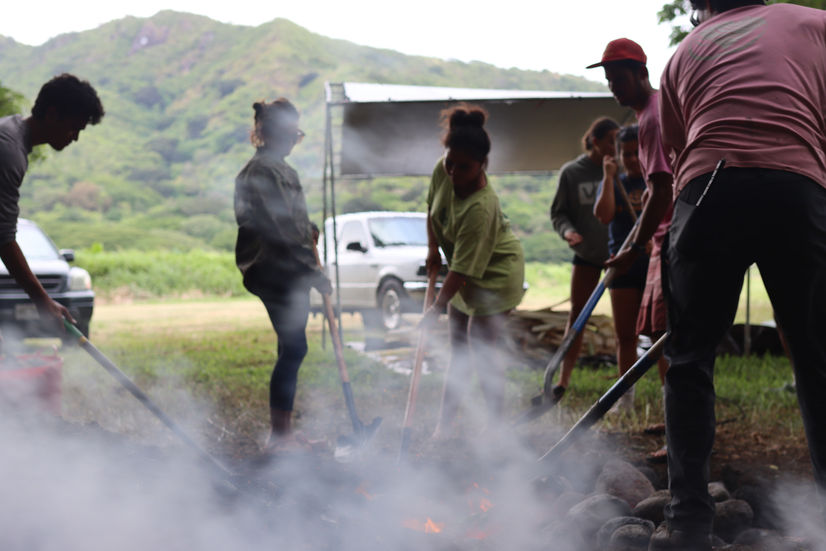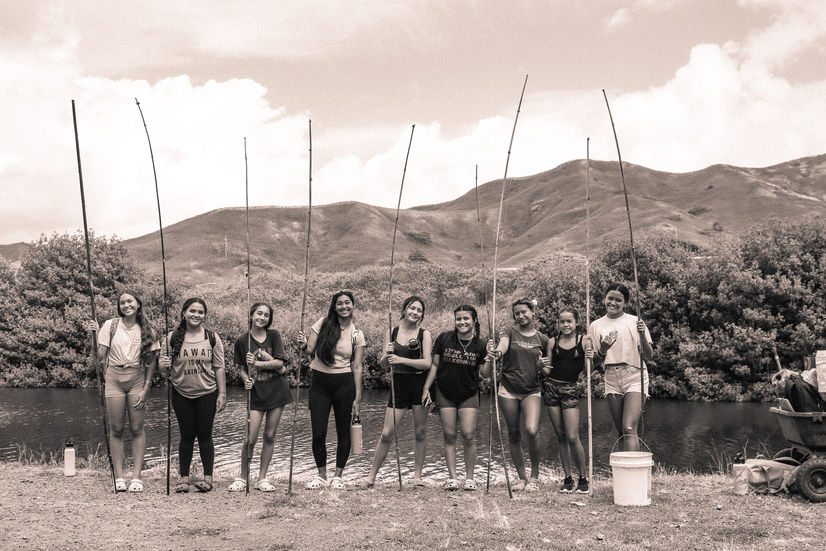

Ka Pahuhopu o Kawainui
Kauluakalana
Kailua, Oʻahu
3-5, 6-8, 9-12
Summer 2023
click on the image to enlarge
Testimonials:
PROGRAM OUTCOMES:
Our ʻAʻe Kū Internship program is inspired and informed by our foundational moʻolelo of Mākālei (the fish attracting branch of Kawainui fishpond). Kahinihiniʻula, the young boy and main character of the story, begins the moʻolelo as a keiki and then goes through training and leadership development with his kūpuna, akua, and aliʻi in order to prepare him to carry additional kuleana for his community at the end of the story. With Kahinihiniʻula and his moʻolelo as our guide, our ʻAʻe Kū program is designed as mini, work-based learning internships for past participants of Ka Pahuhopu o Kawainui but who have aged out of the program (15-18 years olds). It is an opportunity for these older ʻōpio to grow and transition into a new space of learning with us on ʻāina in order to support and nurture their growth as young ʻāina leaders, who we define as those who know the stories and histories of their ʻāina, who have experienced their place firsthand by “komo i ka ʻāina” (being in/on the land), who have developed an understanding of the cultural values and lessons of their kumu and kūpuna, and who have a developed sense of kuleana to cooperatively work with and support their ʻohana and community.
The journey to become an ʻāina leader is a life-long one that we are all traveling, learning and growing along the way. This Summer’s program aimed to help our ʻAʻe Kū along their journey by focusing on activities that mirrored some of the same types of experiences Kahinihiniʻula went through as part of his training in the story, from traveling to other ahupuaʻa to learn from other’s and their ʻāina (we went to Kānewai spring in Maunalua) to assessing the health of the ahupuaʻa (we went fishing in Kawainui to test their toxicity levels) to sailing (we sailed on Uluwehi in Maunalua bay) and much more. As our ʻAʻe Kū participated in each activity, they had to hōʻike or demonstrate their learning along the way including learning new mele and then each having the kuleana to lead the opening and closing protocol, each choosing an appropriate ʻōlelo noʻeau to explain and then guide their work each day, stepping forward to do more demanding mālama ʻāina work, harvesting, preparing, and cooking food that they helped cultivate in an imu that they helped to build in order to feed themselves and their families, as well as retelling the foundational moʻolelo of our program completely on their own and then based on this foundational knowledge that they have been building with us over the years, they worked in small groups to hoʻokaʻao or compose their own kaʻao as ways to remember names and important lessons needed to mālama our ʻāina and community.
In addition to these different forms of authentic assessment, which allowed our ʻAʻe Kū interns to demonstrate in context the knowledge and skills they gained while working with us, they also completed post-reflection surveys (100% response rate) where they were able to reflect on the impacts of the internship on not only their cultural identity and growth as ʻāina leaders but also their educational, professional, and personal journeys.
· 100% said the program impacted their understanding of my kuleana to the ʻāina and community of Hawaiʻi, with an additional 44% saying it impacted their educational path and 55% saying it impacted their professional path, with one intern even saying that “This internship, like the past programs, made me want to learn more about our history and culture. This internship also made me, more now than ever, want to learn ʻŌlelo Hawaiʻi. I never really had the opportunity to learn, and this internship made me realize how important it is to learn our language."
· 100% said they would return to the program and recommend it to others.
· “Some ʻāina leadership skills I learned from our mentors/supervisors is helping where is needed and not being afraid to jump right into the next activity. I also learned the art of telling moʻolelo, and how important of a skill it is. It's not easy remembering all the details of a story and being able to tell it well, so it’s such an important skill to learn, and our mentors/supervisors did very well in teaching it to us.”
· “My knowing the stories of my ʻāina has developed. Through our moʻolelo making I was able to recall the stories and be reminded by Uncle Kaleo, which lead to me making my own moʻolelo.”
· “I think that I developed the most in komo i ka ʻāina because this program we were on the ʻāina every day for two weeks and we had to help in the ʻāina so that at the end of the program we could have a imu and enjoy the food.”
· “This program impacted my educational path by having great kumu who I can listen to so that later in my life I can educate the next generation. If I chose to be a kumu I have a lot of examples I can follow. I intend to continue to malama ʻāina in Kailua and with my school.”
In addition to our ʻAʻe Kū post reflection surveys, we also ask the parents (100% response rate) to reflect on the program in their own surveys. 100% of parents shared that ...
· our program exceeded our four learning outcomes (listed below).
· rated their level of satisfaction with the program at the highest level (5).
· they would encourage their ʻōpio to enroll again.
· they would recommend the program to others.
Here are a few sample responses from parents when asked to share a story of positive growth, impact, or transformation that they observed in their child as a result of their participation:
· We are so happy to see our daughter learn with excitement and interest. Every time we drive past Ulupō we can see her checking on the area and making comments where we can tell she's concerned about the area and wondering what kind of work is being done. There is definitely a sense of pride! We are glad to see that she is growing up to be a good steward of the land. This program has also spiked an interest in more Hawaiian History for her, which is a great plus.
· Our ʻōpio are always both wiped out and full when they participate in your program. The ʻike and pilina - with ʻāina, hoaaloha and each other - will be with them always. The valuable experiences they engage in is shaping how they see themselves and the world, we are so grateful for the work you do.
· Ma muli o kēia papahana a me na kanaka, he pilina a he kuleana ko kaʻu mau keiki. Mahalo piha no ka hānai i kaʻu mau keiki me aʻu.
We at Kauluakalana are privileged to continue to be a small part of these ʻōpio’s journeys as they continue to grow as ʻāina leaders for our community. The combination of these formative and summative assessments help us to feel confident that not only did our program make a lasting impact on these ʻōpio and their families but we also met our intended learning outcomes listed here:
· To increase the number of youth who are studying, practicing, and promoting land-based, Hawaiian cultural knowledge, values, and skills unique to Kailua at storied places in our ahupuaʻa.
· To restore and grow healthy relationship between people (kānaka) and place (ʻāina) through the retelling of Kailua-specific stories, replanting and eating of our ancestral foods, and caring for the sacred sites, lands, and waters of Kailua
· To connect our youth to the ʻāina, culture, values, and community of Kailua
· To support and nurture the next generation of ʻāina leaders who are caring community-minded people, exemplifying Hawaiian values and ʻōiwi leadership
This Summer we also offered Full Summer work-based learning internships for slightly older ʻōpio (18-19) who have also participated in past ʻāina education programs with us and are now transitioning to college. Through our holistic approach, our interns acquired knowledge and skills from a variety of disciplines (e.g., Natural Resource Management, Hawaiian Studies, Hawaiian Language, Archaeology, Agricultural & Aquacultural Economies, several STEM fields), thus setting them up for success in multiple college and career pathways. We recruited, interviewed, and selected interns, giving them valuable, real-world experience, and then immersed them in our three-pronged approach to restoring healthy kanaka-ʻāina relationships:
1) Moʻolelo – Stories have the power to transport us in time, to view ʻāina and space as our kūpuna did, and to bring the vision and apply the lessons in today’s context.
2) Hana/Huli ka lima i lalo – Turning our hands to the ground to physically engage with ʻāina in restorative and regenerative practices.
3) Hānai – Nourishing our community through food grown on site.
Their internship experience culminated in a final hōʻike where we asked them to demonstrate their learning in each of these three areas: retelling the moolelo they learned completely on their own in their own words in front of a group of about 100 community volunteers during one of our Second Saturday workdays; harvesting, cooking, and pounding kalo that they had helped raise during the course of their internship; and harvesting and preparing food that they had helped cultivate in an imu that they helped to build. This authentic form of assessment allowed us to feel confident that we had fulfilled our overal learning outcome of nurturing the next generation of Native Hawaiian leaders and allies rooted in their identities who will become change agents committed to effecting lasting, systems change for the benefit of both the ʻāina and kānaka of Hawaiʻi.











